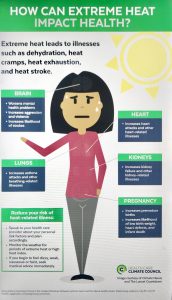
Record high temperatures are in the news again. My Green Doctor explains who is most vulnerable, the health risks of extreme heat, and how to prevent them. We provide free brochures and posters to print for the home, healthcare office or clinic.
When thinking about climate change, what first comes to mind is warmer temperatures. The average world surface temperature has risen about 1.2° F. (0.8° C.) over the past 140 years. That doesn’t sound like much. The full story is that climate change brings greater fluctuations–greater extremes–to the weather. There are more hot days in summer and more extreme cold ones in winter. The warmth is putting more water into the clouds from evaporation so there are more extreme events of rain, tornadoes, hurricanes and cyclones.
Where I live, in the S.E. United States, the average temperature has not risen. In fact, a few areas have seen a slight cooling. But extreme events are up: more dangerously hot days, more heavy rains, more hurricanes, and more damaging floods.
Who is At Risk?
The most vulnerable are young children, people who work outdoors, the elderly, and those with cardiac or respiratory conditions. It is common for tourists to collapse with exhaustion caused by extreme heat when they travel and do not take the appropriate precautions. Certain medications make patient vulnerable, particularly diuretics and anti-hypertensives. Women in late pregnancy must be especially cautious. In less than 30 seconds, health professionals can identify which patients are at risk, make them aware of the dangers of extreme heat, and advise them on how to stay safe.
Health Effects
The health effects of extreme heat run a spectrum from muscle cramps (“heat cramps”), to heat exhaustion (“heat collapse”), heat stroke, and death. The early warning signs that require immediate rest, oral fluids and a cool shelter include muscle cramps, intense sweating, headache, nausea, dizziness, and weakness.
Air pollution is worse with hot temperatures because more fossil fuels are burned to power air conditioners and because more pollution is converted to dangerous ozone. All this means more asthma attacks, breathlessness, and heart attacks. Extreme rain events, flooding, tornadoes and hurricanes kill those who are not prepared.
Taking Precautions
Here are simple precautions to protect against heat-related illness:
- Be aware of the weather forecast every day.
- Be familiar with the signs and symptoms of heat exhaustion.
- When outdoors, limit physical exertion, stay in the shade, and wear a hat & loose clothing.
- Drink plenty of non-alcoholic, non-caffeinated fluids; eat lightly.
- When indoors, close curtains and blinds to keep out sunlight; take cool showers and baths.
- Use air conditioning; but know where you will go if the a/c fails or if you need a local cooling center.
- Establish a “buddy system” so that someone is looking out for you.
There is a lot that government can do to protect communities:
- Expand local green spaces and plant more trees to reduce urban heat islands.
- Paint surfaces white, such as roofs, asphalt, and parking lots.
- Establish heat monitoring and public warning systems.
- Set up local cooling centers and provide transportation to these centers.
- Create social support networks across vulnerable populations.
Easy-to-read brochures and posters on “Extreme Heat”, for office waiting rooms, staff break rooms, and examination rooms are found at https://mygreendoctor.es/resources/waiting-room-brochures/ , created by the Healthcare Climate Council. The brochure comes as a two-page, folded brochure and also as a two-page, front & back, non-folded handout.
Author: Todd Sack is Editor of www.MyGreenDoctor.org, a free environmental sustainability service for healthcare office. My Green Doctor partners with eleven health professional societies to provide this money-saving membership benefit. My Green Doctor is how health professionals share wise ideas with their patients and prepare communities for the health risks from climate change.



